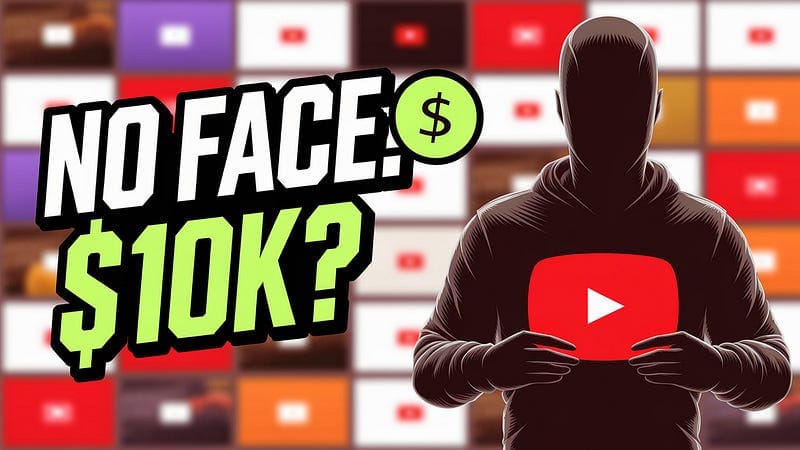How to Start a Faceless YouTube Channel (and Actually Make Money in 2025)
The step-by-step guide using AI tools like ElevenLabs, Fiverr, and Opus Clip

Why Faceless YouTube Channels Are Winning
You don’t need to be famous or even show your face to succeed on YouTube anymore. In fact, faceless channels — where the creator never appears on camera — are not only growing fast but are often more scalable and profitable than traditional YouTube channels.
With free and affordable tools like ElevenLabs for AI voiceovers, Fiverr for outsourcing, and Opus Clip for Shorts, it’s now possible to build an entire channel from your laptop.
This guide will show you:
- How to choose a profitable, low-competition niche
- The difference between long-form and short-form content
- What tools you need (and what to avoid)
- Step-by-step instructions to make and upload videos
- Monetization strategies
- Real case studies of faceless creators earning money
- How to scale and build a long-term YouTube business
Let’s dive in.
Step 1: Choose a Niche with High Demand and Low Competition
Your niche is the category or topic your channel focuses on. Some examples: personal finance, AI tutorials, psychology facts, DIY crafts, relaxing music, or animated stories.
But don’t just pick what’s popular. Instead, look for the sweet spot:
High demand + low competition = growth potential
How to Find a Good Niche:
- Use Google Trends — Search your topic. Does interest stay consistent or grow over time?
- Search on YouTube — Are there lots of videos? If yes, do newer channels get views, or is it all dominated by big creators?
- Use vidIQ or TubeBuddy — These show you keyword volume and competition scores.
- Check RPM Potential — Some niches (like finance) earn more money per 1,000 views than others.
Top Profitable Niches for Faceless Channels:
Pro Tip: Avoid overcrowded niches unless you bring a unique twist or target a specific sub-niche (e.g., “finance for digital nomads”).
Step 2: Set Up Your Channel Properly
Before you make your first video, build your foundation.
Branding Basics:
- Channel Name: Memorable, niche-related, and simple (e.g. “Finance Fast,” “CalmMind Audio”).
- Profile Picture: Use a logo or icon that fits your style. Canva or Fiverr can help.
- Banner: Include what your channel does + upload frequency (e.g., “New videos every Tuesday!”).
- About Section: Write a short paragraph describing your niche, who it’s for, and what viewers can expect.
Create a Channel Trailer:
- A 30–60 second faceless video that welcomes new viewers.
- Tell them what your channel is about, who it helps, and ask them to subscribe.
Keep it clean, professional, and consistent. Even for faceless channels, branding builds trust.
Step 3: Understand Long-Form vs Shorts
YouTube now favors a mix of content:
Long-form videos keep people on the platform.
Shorts get you discovered.
Long-Form Videos (8–15 minutes):
Pros:
- Higher ad revenue
- Easier to build trust
- Great for tutorials, storytelling, deep dives
Cons:
- Takes more time to script and edit
- Requires better visuals to keep people watching
Shorts (under 60 seconds):
Pros:
- Fast to create
- Can go viral quickly
- Boost subscriber count
Cons:
- Lower monetization (though improving)
- Less time to build trust or explain ideas
Best Strategy:
- Use Opus Clip to automatically turn your long videos into multiple Shorts.
- Add calls to action like “See the full video on my channel” to drive traffic.
Step 4: Plan and Batch Content
Planning ahead makes content creation 10x easier.
How to Batch Content:
- Brainstorm 10–20 video ideas using tools like vidIQ, ChatGPT, or Reddit.
- Write titles first. This helps you stay focused and create click-worthy videos.
- Group content into series or playlists (e.g., “5 videos on money-saving tips”).
- Create 2–3 long videos and 10+ Shorts at once, then schedule over 2–3 weeks.
People binge playlists. Grouping videos keeps them on your channel longer.
Step 5: Create Videos Without Showing Your Face
Step-by-Step Workflow:
Write a Script
- Start with a hook: ask a question or state a surprising fact.
- Break it into sections or list points.
- Use a casual, clear tone.
- Use ChatGPT to help you write or rewrite it faster.
Generate Voiceover with ElevenLabs
- Paste your script into ElevenLabs.
- Choose a natural voice (you can clone your own too).
- Download the audio in high quality.
Add Visuals
- Stock footage: Pexels, Pixabay, Storyblocks
- AI images: Leonardo AI, Midjourney
- Screen recordings (tutorials): OBS Studio or Loom
- Use B-roll (cutaway visuals) to make it visually dynamic.
Edit Video
- Use Pictory or CapCut for easy editing.
- Sync visuals with voiceover.
- Add music (YouTube’s Audio Library or Epidemic Sound).
- Add transitions, zoom-ins, and captions to keep attention.
Design a Clickable Thumbnail
- Use Canva or Photopea
- Big bold text (2–3 words max)
- Bright colors and contrast
- AI-generated visuals or custom photos
Step 6: Upload & Optimize Your Video
Here’s how to upload a video that gets found:
Title: Start with a keyword. Add curiosity or a bold statement.
- “How I Saved $10,000 Without Budgeting”
- “This AI Tool Just Replaced 5 Freelancers”
Description: Write 2–3 keyword-rich paragraphs. Add timestamps, affiliate links, and a CTA to subscribe.
Tags: Use 5–10 relevant keywords with TubeBuddy or vidIQ.
Thumbnail: Upload custom thumbnail (avoid using YouTube’s random frame).
End Screens + Cards: Link to related videos/playlists to increase watch time.
Step 7: Repurpose into Shorts with Opus Clip
- Upload your long video into Opus Clip
- It automatically finds high-performing moments
- Adds captions, crops to vertical, and gives it a “virality score”
- Download and upload to YouTube Shorts, Instagram Reels, TikTok
One 10-minute video = 5–10 Shorts. Multiply your reach with no extra work.
Step 8: Monetize Your Channel (and Make It Sustainable)
Once you hit 1,000 subscribers and 4,000 hours of watch time, you can turn on ads.
Main Monetization Streams:
Some small channels earn more from sponsorships than ads. One faceless finance channel earned $973 from ads but $3,600+ from one sponsor.
Step 9: Common Mistakes to Avoid
- Using other people’s footage without permission — Use royalty-free or AI-generated visuals.
- Overusing robotic AI voices — Use realistic voices from ElevenLabs or hire on Fiverr.
- Making unfocused content — Every video should have a clear topic and structure.
- Ignoring thumbnails and titles — These determine your click-through rate.
- Not engaging with your audience — Reply to comments, pin useful ones, build community.
Step 10: Scale Up Like a Pro
Once you start earning and growing, here’s how to take it further:
- Outsource editing to Fiverr or Upwork
- Hire scriptwriters or voiceover artists
- Post Shorts daily to stay in the algorithm
- Start a second channel in a related niche
- Turn video scripts into blog posts for SEO traffic
- Sell your own products or build an email list
Bonus: How to Turn Shorts Viewers into Long-Form Subscribers
Shorts are great for exposure — but you need to guide those viewers to your main content.
How to Convert Them:
- Mention your long video in the Short: “Full story on my channel”
- Pin a comment with the link
- Add the video link in your channel description
- Make the Short a “cliffhanger” (e.g., “Here’s part 1…”)
- Use Shorts to test ideas and expand successful ones into full videos
You Can Do This
Starting a faceless YouTube channel in 2025 is one of the smartest ways to build passive income and creative freedom. With the right tools, smart planning, and a bit of consistency, you can grow a channel that earns money without ever showing your face.
You don’t need to be perfect. Just get started.
- Choose your niche
- Make your first video
- Repurpose and optimize
- Focus on value and consistency
- Scale over time
The YouTube algorithm doesn’t care about your face. It cares about watch time, quality, and clicks — and that’s something anyone can master.





